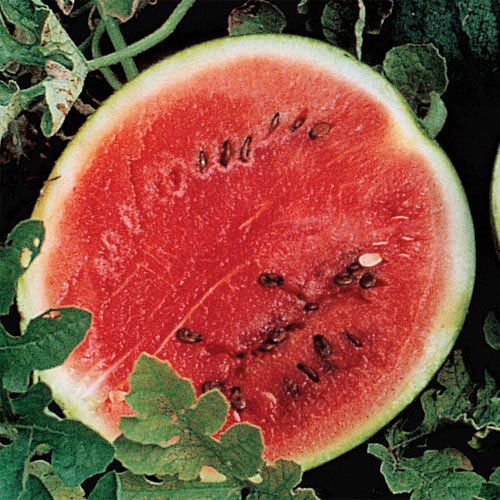Watermelon is a refreshing summertime treat—and a favorite for eating at picnics and slicing up into fruit salads. Low in calories, it’s a good source of dietary fiber and vitamin C. Growing your own watermelon is fun, and when you grow your own melons, you can choose varieties not typically found in the grocery stores.
Here are some watermelon types to consider:
Small or personal-sized melons: Usually weighing 6-12 lbs., these smaller melons are great for gardeners with limited space. The vines don’t take up as much space on other varieties—and it’s easy to fit the fruits into the refrigerator. They can be seeded or seedless.
Medium, or family-sized melons: Usually weighing 16-20 lbs., these are some of the most popular watermelon varieties to grow. The fruits are big enough to feed several people—but they can still fit in the refrigerator. They can be seeded or seedless.
Large, or picnic-sized melons: Often weighing 30 lbs. or more, these melons can feed a crowd—and they’re fun to grow. Because of their size, though, they usually take the longest to reach maturity. They can be seeded or seedless.
Seedless watermelon: Eating is easy and not as messy with seedless varieties. When growing seedless watermelon, though, you must also plant a seeded variety for pollination.
Early maturing watermelon: Because watermelon is a warm-season crop with a long growing period, it can be a challenge for northern gardeners with shorter growing seasons. If growing watermelons in northern regions, choose watermelons that take 80-85 days to reach maturity.
Yellow watermelon: Just as flavorful as red watermelons, yellow watermelons are very attractive, especially in fruit salads.
Once you’ve selected what type of watermelon to grow, follow these tips below for how to grow watermelon.
When is the Best Time to Plant Watermelon?
Watermelon seeds can be directly sown into the garden or started indoors and transplanted to the garden. If starting seeds indoors, sow them about 4 weeks before the last spring frost date for your area. Wait to transplant seedlings until all danger of frost has passed. If directly sowing watermelon seed into the garden, the soil temperature should be at least 65 degrees F.
How to Plant Watermelon Seeds
Watermelon plants grow best in full sun and well-drained soil that is slightly acidic to neutral. Mix compost into the soil before planting. Sow the seeds or plant the transplants in small hills. The spacing for watermelon plants will depend on the variety. For most varieties, the hills should be 8 feet apart. If growing smaller watermelon varieties, the spacing can be closer. Plant 4-5 seeds per hill and at a depth of 1/2 to 1 inch deep. After germination, thin to two plants per hill. If transplanting watermelon seedlings, plant two plants per hill.
Growing Watermelon
Watermelon vines require about 1 to 2 inches of water per week. Avoid overhead watering. When watering, water deeply, soaking the soil thoroughly. As the fruits begin to ripen, gradually reduce the amount of water you’re giving the plants. This improves the flavor of the fruits.
Mulching around the plants can suppress weeds and help the soil retain moisture. When weeding around the plants, cultivate shallowly as watermelon roots are close to the soil.
Harvesting A Watermelon Plant
Watermelon fruits do not ripen all at once. Look for visible changes in the fruits to determine when they are ripe and ready for harvest. Common signs are that the tendril at the stem becomes brown and dry; the fruit color looks duller; and the side of the melon in contact with the soil starts to yellow.
After harvest, whole watermelons can be stored at room temperature for about a week and in the refrigerator for up to two weeks.
FAQs
- How to Tell When a Watermelon is Ripe?
The main signs that a watermelon is ripe are that the tendril at the stem dries and the side of the melon in contact with the ground turns light green or yellow. When ripe watermelons are tapped on the side, it sounds like a dull thump.
- How to Protect a Watermelon Plant From Insects & Diseases?
Many insects, including the cucumber beetle, squash vine borer, aphids, and squash bugs, may damage watermelon vines. Inspect your plants frequently for insect damage. To protect your plants from disease, practice crop rotation, avoid overhead watering and clean up garden debris in the fall. Gurney’s offers insect and disease control supplies.
- How to Grow Sweet Watermelons?
To grow sweeter melons, gradually reduce the amount of water to the vines when the fruits start to ripen.
- Can You Grow Watermelon in Pots?
If growing watermelons in pots, choose a large container with good drainage. Select a watermelon variety with more compact vines.

